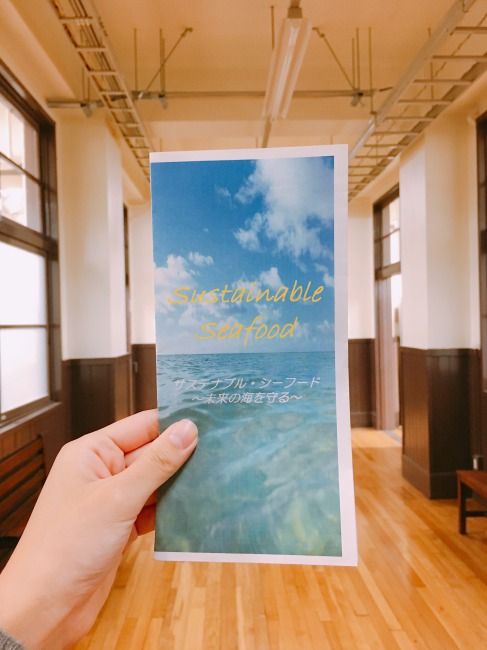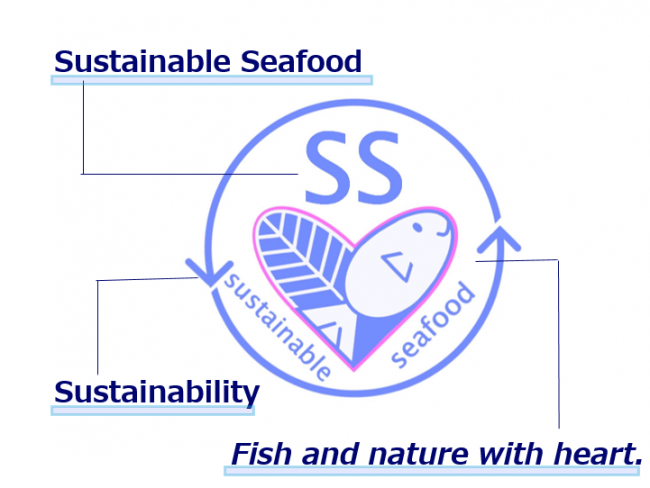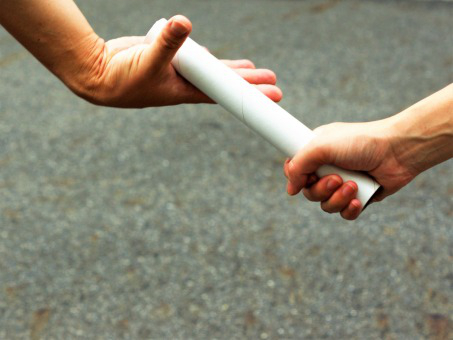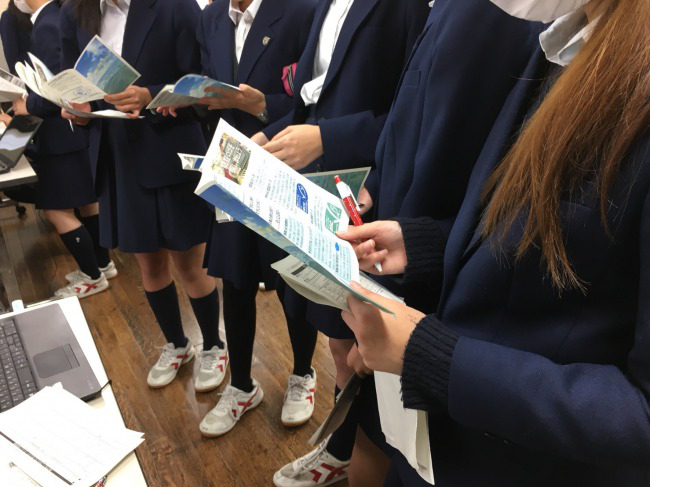Improving awareness
Solution ①Leaflet
・To increase awareness of sustainable seafood and eel catch declining, we made the leaflet.
・A survey was conducted a test whether the leaflet is effective or not.
 Taken by us
Taken by usThe reason why we made the leaflet is that we believe it is an effective way of increasing awareness of people. The main contents of this leaflet are informations about "sustainable seafood", "eel catching declining" and "certification marks". Additionally, we created our original logo mark.
The meaning of logo mark is explained by the picture in the bottom.

By the leaflet is we want to increasing awareness in the following two dimensions.
―To next generation―
 We want to raise the awareness of children. This time we targeted on high school students. The next generation, as people who are holding the future, they should learn about sustainable seafood. Knowing the concept at a relatively young age will ensure that they could make more and more eco-friendly choices in the future.
We want to raise the awareness of children. This time we targeted on high school students. The next generation, as people who are holding the future, they should learn about sustainable seafood. Knowing the concept at a relatively young age will ensure that they could make more and more eco-friendly choices in the future.―To the parent generation―
 We also want to raise the awareness of the parent generation. If the children could pass what they are aware of to the parent generation, parents would realize the crisis and raise make more eco-friendly choices as well.
We also want to raise the awareness of the parent generation. If the children could pass what they are aware of to the parent generation, parents would realize the crisis and raise make more eco-friendly choices as well.Does increasing awareness help this problem?
When we spread the existence of certificated mark, how many people will buy sustainable seafood even if it is little bit expensive? Additionally how much can consumers afford to sustainable seafood?
We thought that we can illustrate usability of spreading awareness by solving those questions.
So, we distributed the leaflet to students in our school to know how much change the students attitude by reading the leaflet. We also validated the effective of increasing awareness by reading it.
Period:November.9,10
The number of participants:219 answers
Contents of questionnaire:Survey on attitude towrd the price of fish.Hypothetically the average price of normal eel is 1000yen. How much can you afford to sustainable seafood.
1.I don't buy more than 1000yen.
2.I buy less than 1100yen.(10%up)
3.I buy less than 1250yen.(25%up)
4.I buy less than 1500yen.(50%up)
5.I buy less than 2000yen.(100%up)
6.I buy less than 3000yen.(200%up)
7.Even if I buy more than 3000yen.
Result:
The graph is the results of this survey.
Pangasius(a white-meat fish) which have ASC logo is a little on the market and it's doubled price compare with normal one.
Thus, we apply eel to this example.
The number of people who answered "I buy less than 2000yen" and "Even if I buy more than 3000yen" was increased from 7 to 18.
This means that the percentage of people who will buy indeed certificated products, even if its price is more expensive than normal one by getting mark, went up 60%.
Next, we pay attention to the two graphs. The blue graph shows the number of people who answered the questions before reading the leaflet.
The red graph shows the number of people who answered the questions after reading leaflet.
The red graph deviated to the right side from blue side. This means that by reading this leaflet, people who will buy sustainable seafood which price is little bit expensive than usual increase through reading this leaflet.
Thus we can say that our leaflet is effective to change consumers' attitude.
 On November.15, we reported our activity in our school. We showed our website and distributed the leaflet to the students. They said "We can understand easily about the contents."
On November.15, we reported our activity in our school. We showed our website and distributed the leaflet to the students. They said "We can understand easily about the contents."You can download our leaflet from following URL.
Leaflet










